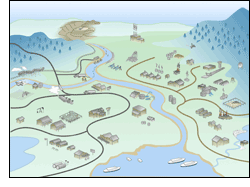Research Individual Chemicals

Each
of the pages within ITEP's Hazardous Substance Website will provide possible "Contaminants of Concern" for you to consider
when identifying what hazardous substances may exist in your community. However, this is not a comprehensive list and should be used
as a tool to expand awareness of possibilities. Some of the most common chemicals people may be exposed to are explored in more detail
in "Related Pages."
More than 800 hazardous substances are listed under the
Comprehensive Environmental Response, Compensation, and Liability Act (CERCLA)
- also known as the
Superfund law. These are substances
that are considered
severely harmful to
human health and the environment
. Many are commonly used substances which are harmless in their normal uses, but are quite dangerous
when released.
Superfund's definition of a hazardous substance includes the following:
- Any element, compound, mixture, solution, or substance designated as hazardous under section 102 of CERCLA.
-
Any hazardous substance designated under section 311(b)(2)(a) of the Clean Water Act (CWA), or any toxic pollutant listed
under section 307(a) of the CWA. There are over 400 substances designated as either hazardous or toxic under the CWA.
-
Any hazardous waste having the characteristics identified or listed under section 3001 of the Resource Conservation and
Recovery Act.
-
Any hazardous air pollutant listed under section 112 of the Clean Air Act, as amended. There are over 200 substances listed
as hazardous air pollutants under the Clean Air Act (CAA).
-
Any imminently hazardous chemical substance or mixture which the EPA Administrator has "taken action under" section
7 of the Toxic Substances Control Act.
Hazardous waste is defined under the Resource Conservation and Recovery Act (RCRA) as a solid waste (or combination of solid wastes)
which, because of its quantity, concentration, or physical, chemical, or infectious characteristics, may: (1) cause or contribute to
an increase in mortality or an increase in serious irreversible, or incapacitating illness; or (2) pose a substantial present or
potential hazard to human health or the environment when improperly treated, stored, transported, disposed of, or otherwise managed.
In addition, under RCRA, EPA establishes four characteristics that will determine whether a substance is considered hazardous,
including ignitability, corrosiveness, reactivity, and toxicity. Any solid waste that exhibits one or more of these characteristics
is classified as a hazardous waste under RCRA and, in turn, as a hazardous substance under Superfund.
Although the terms "hazardous substance" and "pollutant or contaminant" do not include petroleum or natural gas,
ITEP has developed pages discussing petroleum products. EPA conducts emergency responses to incidents involving petroleum and
non-petroleum oils separately from its responses to hazardous substance incidents. Throughout the Emergency Response Program, the
term "hazardous substance" includes pollutants and contaminants.
In addition to the hazardous substances identified under the Superfund law, the Title III amendments to Superfund, also known as
the
Emergency Planning and Community Right-to-Know Act (EPCRA),
identifies several hundred hazardous substances known for their extremely toxic properties. EPA designated them as "extremely
hazardous substances" to help focus initial chemical emergency response planning efforts.
The annotated websites on this page are resources we have identified that provide information specific to thousands of chemicals.
They are arranged below by Information Organized by Chemical, Chemical Databases, and Chemical Information.
 ITEP
ITEP Each
of the pages within ITEP's Hazardous Substance Website will provide possible "Contaminants of Concern" for you to consider
when identifying what hazardous substances may exist in your community. However, this is not a comprehensive list and should be used
as a tool to expand awareness of possibilities. Some of the most common chemicals people may be exposed to are explored in more detail
in "Related Pages."
Each
of the pages within ITEP's Hazardous Substance Website will provide possible "Contaminants of Concern" for you to consider
when identifying what hazardous substances may exist in your community. However, this is not a comprehensive list and should be used
as a tool to expand awareness of possibilities. Some of the most common chemicals people may be exposed to are explored in more detail
in "Related Pages."